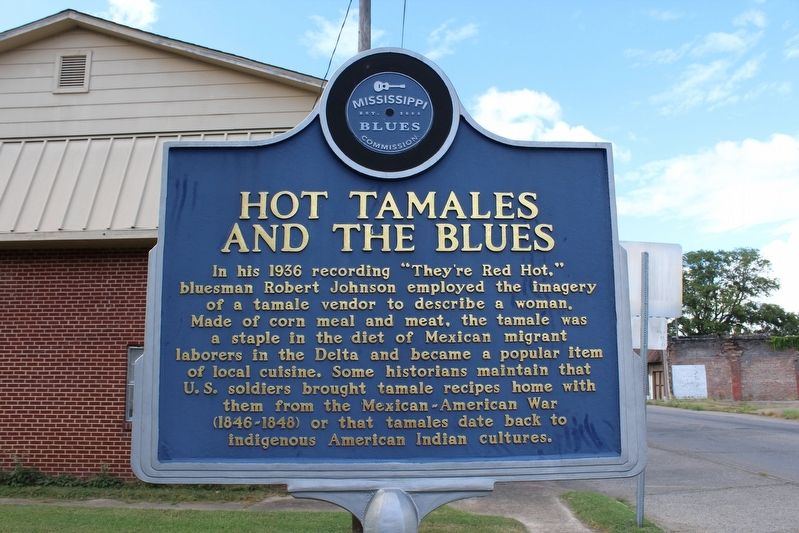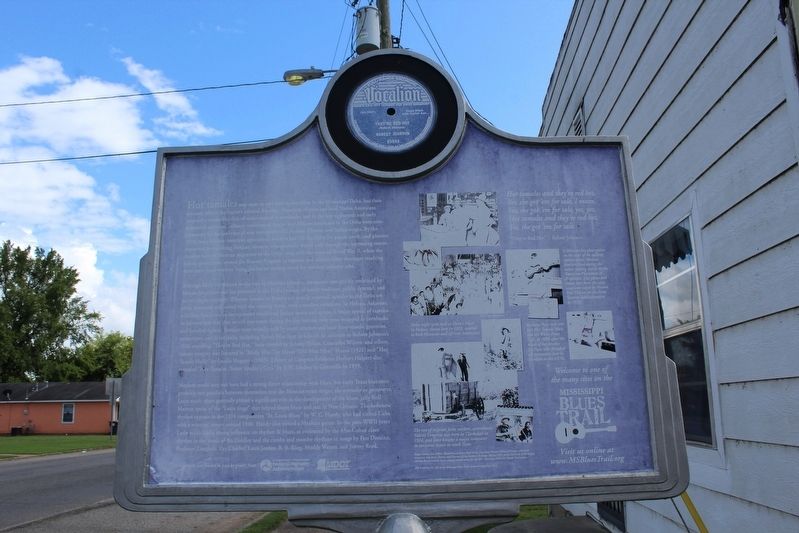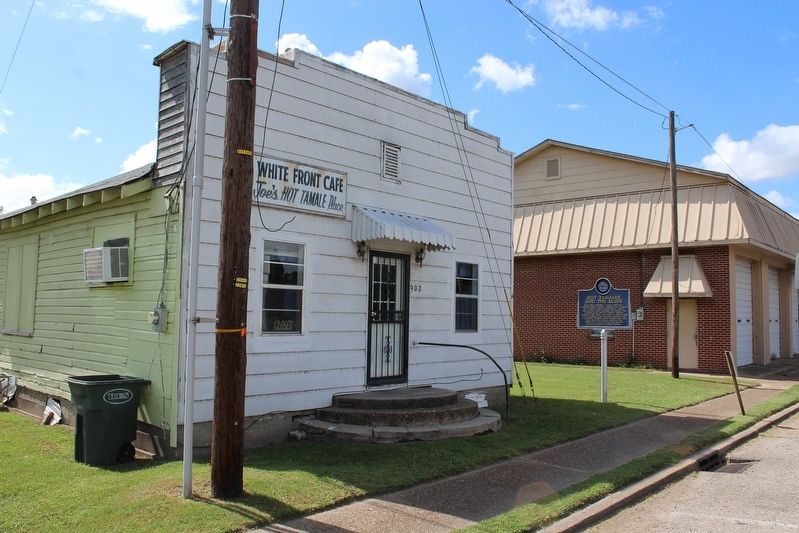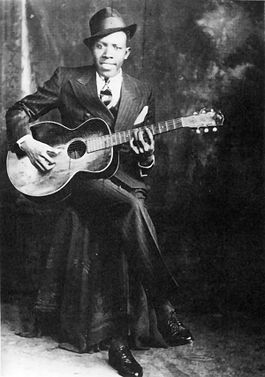Rosedale in Bolivar County, Mississippi — The American South (East South Central)
Hot Tamales and the Blues
In his 1936 recording “They’re Red Hot,” bluesman Robert Johnson employed the imagery of a tamale vendor to describe a woman. Made of corn meal and meat, the tamale was a staple in the diet of Mexican migrant laborers in the Delta and became a popular item of local cuisine. Some historians maintain that U.S. soldiers brought tamale recipes home with them from the Mexican-American War (1846-1848) or that tamales date back to indigenous American Indian cultures.
(back)
Hot tamales may seem an odd food to encounter in the Mississippi Delta, but their presence reflects the region's cultural diversity. Hundreds of years ago local Native Americans prepared a tamale-like dish of maize cooked in cornhusks, and in the late eighteenth and early nineteenth centuries, culinary traditions of Anglo- and African-Americans in the Delta were complemented by the foodways of new immigrants of Lebanese, Chinese and Italian origin. By the 1920s many African-American agricultural workers had left the Delta for points north, and planters responded by recruiting Mexican laborers, who generally stayed only through the harvesting season. Another wave of Mexican migration to the Delta came with the onset of World War II, when the federal government started the Bracero Program to regulate and address labor shortages resulting from many local workers' being drafted or moving north for wartime industry jobs.
Although likely introduced to the area by Mexican laborers, the tamale was quickly embraced by African Americans and has persisted in the Delta because of family tradition, public demand, and out of simple necessity. Whereas tamales in Mexico are usually steamed, tamales in the Delta are often simmered and served with the cooking water, with countless variations. In Helena, Arkansas, a Sicilian family recipe incorporated traditional Italian meats and spices. A major appeal of tamales to laborers was that they would stay warm during the day because they were wrapped in cornhusks and bundled tightly. Tamales were initially sold by street vendors and later from stands, groceries, restaurants, and blues clubs, including Ruby’s Nite Spot in Leland. In addition to Robert Johnson’s 1936 recording "They're Red Hot," later covered by Johnny Shines, Cassandra Wilson, and others, tamale imagery was featured in "Molly Man" by Moses “Old Man Mose” Mason (1928) and "Hot Tamale Molly" by Lucille Hegamin (1925). Library of Congress folklorist Herbert Halpert also recorded "Hot Tamales (Street Vendor's Cry)" by F. W. Lindsey in Greenville in 1939.
Mexican music may not have had a strong direct relationship with blues, but early Texas bluesmen probably saw parallels between themselves and the Mexican street singer, the trovador or guitarerro. Latin music more generally played a significant role in the development of the blues. Jelly Roll Morton spoke of the “Latin tinge” that helped shape blues and jazz in New Orleans. The habanera rhythm appears in the 1914 composition "St. Louis Blues" by W. C. Handy, who had visited Cuba with a minstrel troupe around 1900. Handy also owned a Mexican guitar. In the post-WWII years Latin music had a strong influence on rhythm & blues, as evidenced by the Afro-Cuban clave rhythm in the music of Bo Diddley and the rumba and mambo rhythms in songs by Fats Domino, Professor Longhair, Ray Charles, Louis Jordan, B. B. King, Muddy Waters, and Jimmy Reed.
(captions)
Hot tamales and they’re red hot, Yesshe got ‘em for sale, I mean. Yes, she got ‘em for sale, yes, yes. Hot tamales and they’re red hot, Yes, she got ‘em for sale. “They’re Red Hot” – Robert Johnson
A Mexican boy plays guitar on the steps of the railway station where Mexican families lived during the cotton picking season on the Knowlton Plantation in Perthshire. This photo and others here from the same area were taken by Marion Post Wolcott for the Farm Security Administration in 1939.
Delta night spots such as Dova’s Place in Helena, shown here in 1939, catered to both Mexicans and African Americans.
Barbara Pope took over Joe’s Hot tamale Place, aka the White Front Café, in 2004 after the death of her brother Joe Pope, who founded the restaurant here in Rosedale in the 1970s.
The son of migrant farm workers, accordionist Valerio Longoria was born in Clarksdale in 1924, and later became a major innovator in conjunto music in south Texas.
Erected 2011 by Mississippi Blues Commission. (Marker Number 138.)
Topics and series. This historical marker is listed in these topic lists: African Americans • Arts, Letters, Music • Entertainment. In addition, it is included in the Mississippi Blues Trail series list. A significant historical year for this entry is 1936.
Location. 33° 51.133′ N, 91° 1.66′ W. Marker is in Rosedale, Mississippi, in Bolivar County. Marker is at the intersection of Main Street (State Highway 1) and Brown Street, on the left when traveling north on Main Street. Touch for map. Marker is in this post office area: Rosedale MS 38769, United States of America. Touch for directions.
Other nearby markers. At least 8 other markers are within 14 miles of this marker, measured as the crow flies. Rosedale Courthouse (about 600 feet away, measured in a direct line); To Memorialize Bolivar County's First Two Brick Courthouses (about 700 feet away); Rosedale (about 700 feet away); Grace Episcopal Church (approx. 0.3 miles away); Mildrette Netter (approx. 0.4 miles away); Otis Clay (approx. 5.8 miles away); Christmas Mound (approx. 6.3 miles away); Eddie Shaw (approx. 13.9 miles away). Touch for a list and map of all markers in Rosedale.
Also see . . . Robert Johnson-They're Red Hot (video). YouTube (Submitted on August 15, 2020, by Tom Bosse of Jefferson City, Tennessee.)
Credits. This page was last revised on August 16, 2020. It was originally submitted on August 15, 2020, by Tom Bosse of Jefferson City, Tennessee. This page has been viewed 286 times since then and 33 times this year. Photos: 1, 2, 3, 4. submitted on August 15, 2020, by Tom Bosse of Jefferson City, Tennessee. • Bernard Fisher was the editor who published this page.



